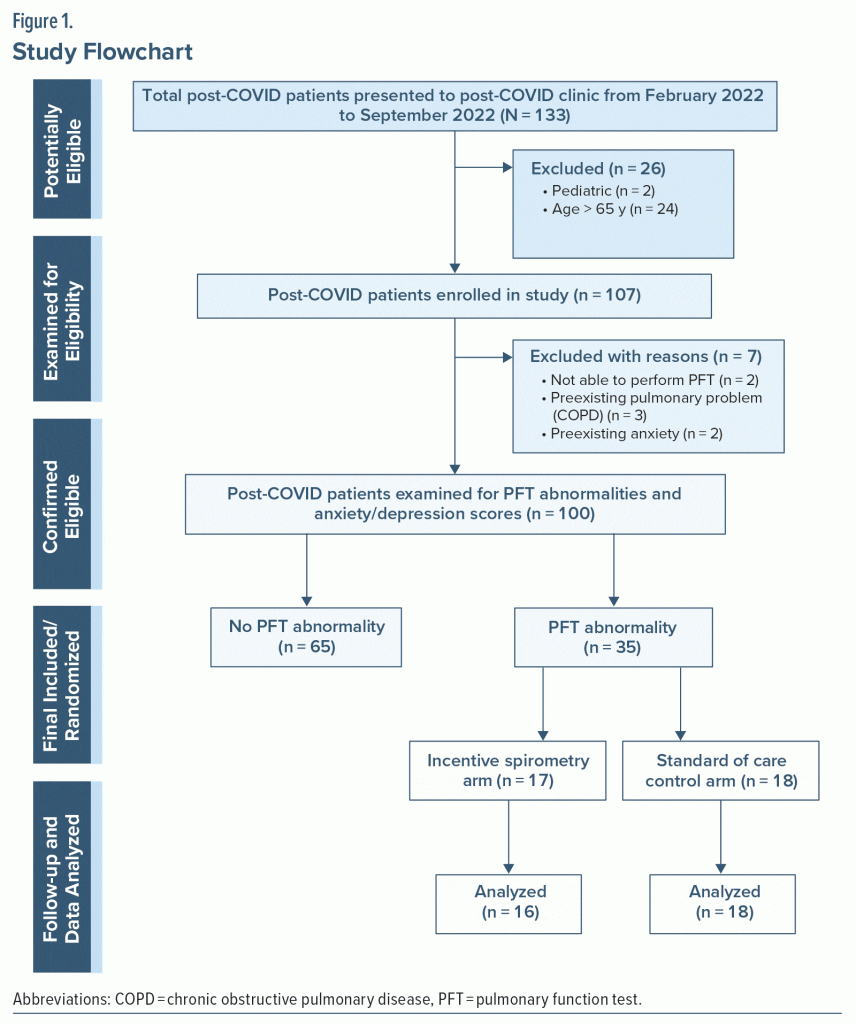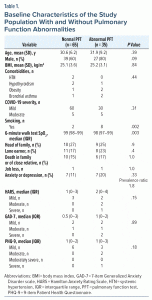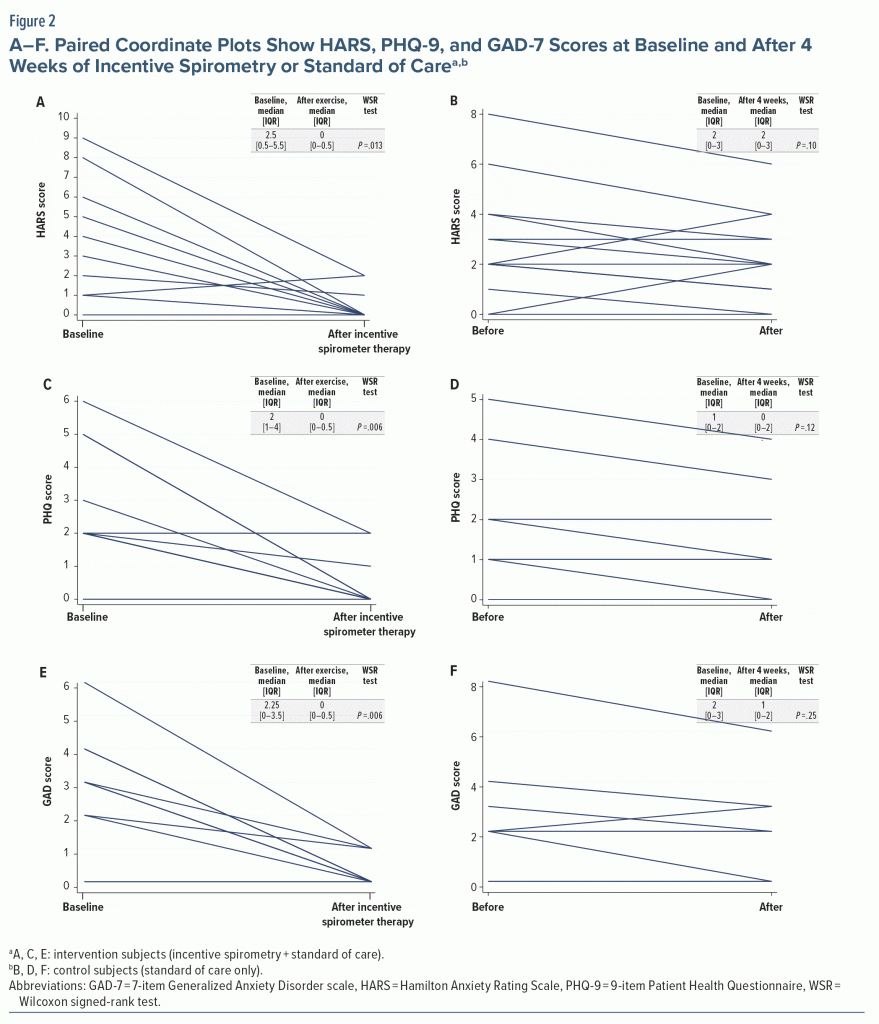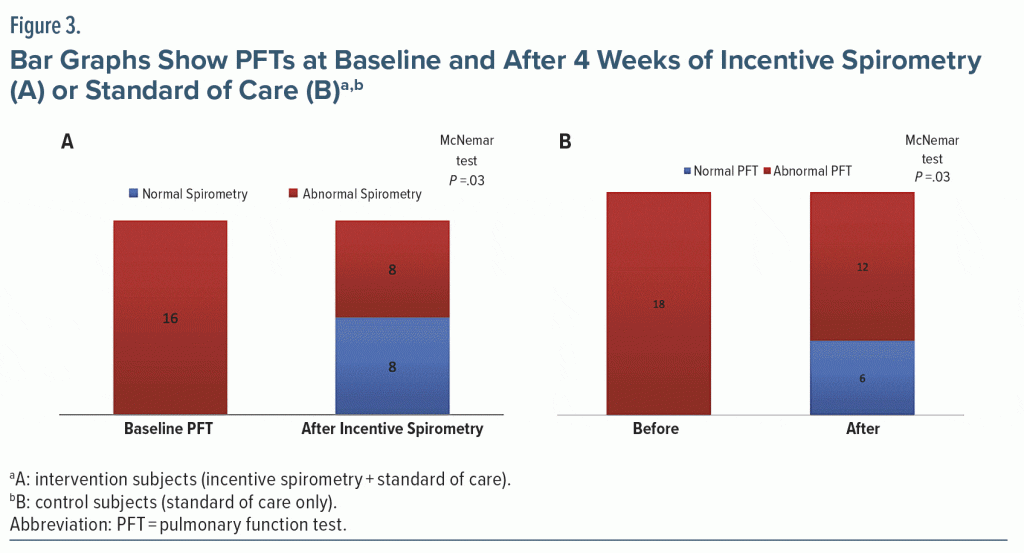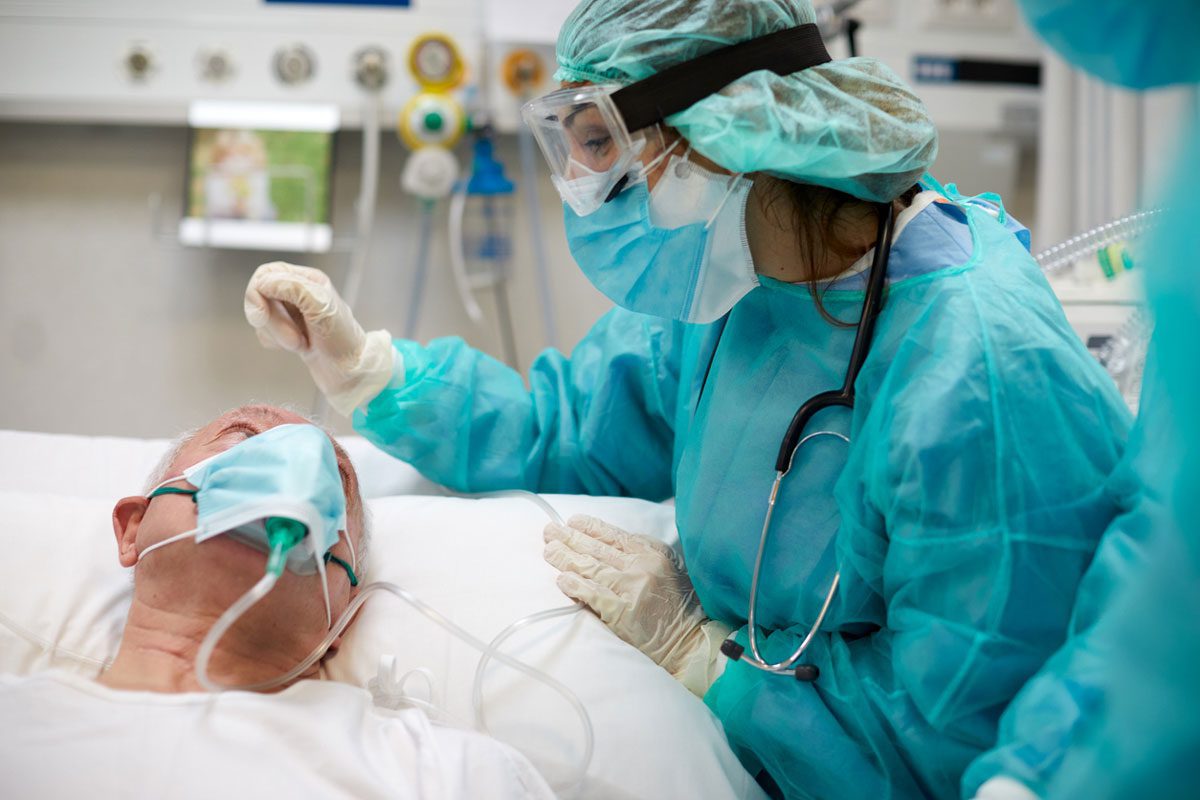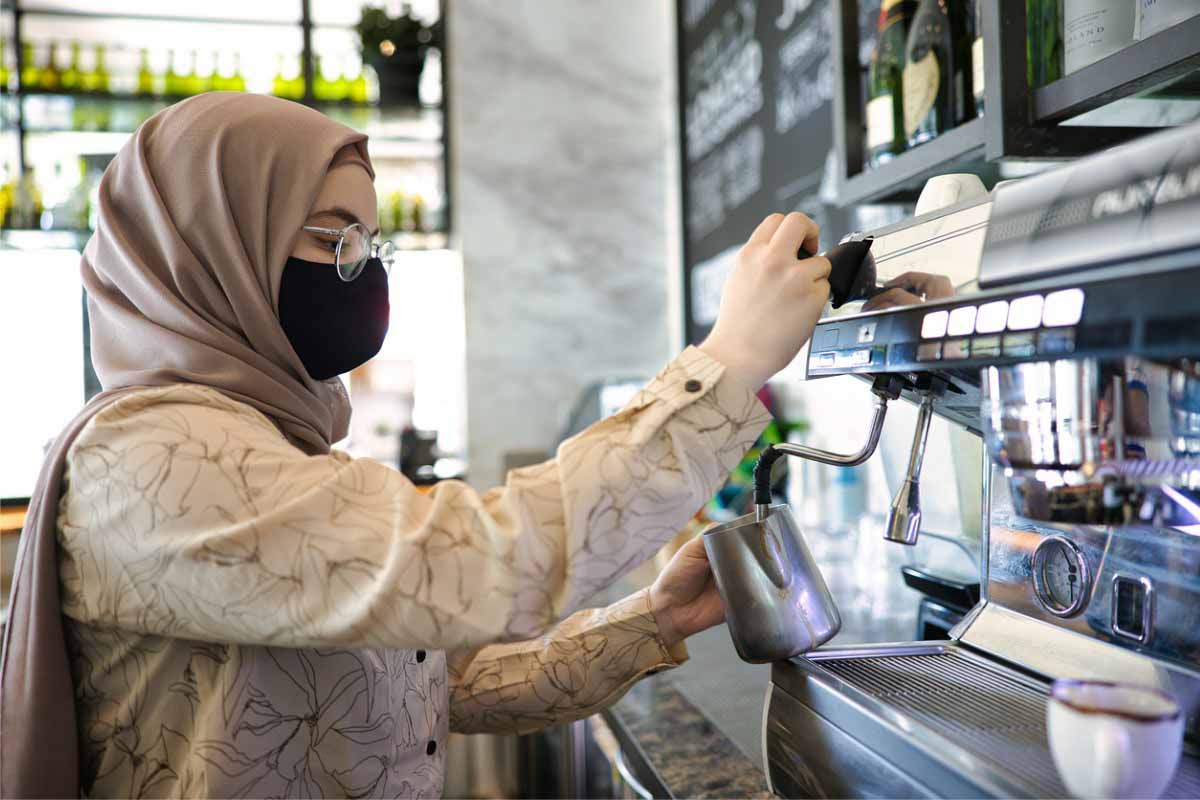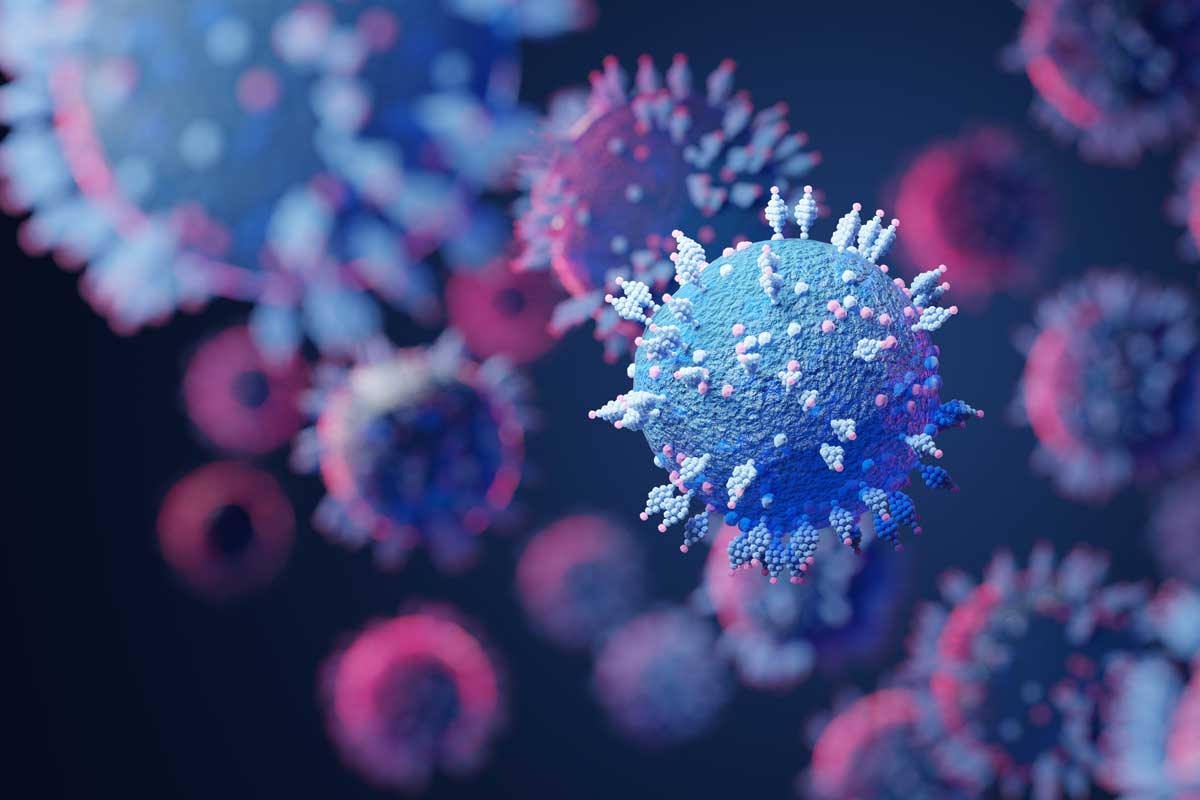ABSTRACT
Objective: To determine the rates of new-onset anxiety and depression in patients with restrictive or obstructive lung disease after COVID-19 infection and to assess the improvement in pulmonary functions and anxiety/depression scores after prescribing incentive spirometer-based breathing exercises.
Methods: A 2-phase study with a cross-sectional and open-label randomized interventional design evaluated anxiety (Generalized Anxiety Disorder-7 [GAD-7] and Hamilton Anxiety Rating Scale [HARS]), depression (Patient Health Questionnaire-9 [PHQ-9]), and pulmonary function tests (PFTs) of 100 COVID-19 patients within 8 weeks of acute illness. Patients with pulmonary dysfunction were randomized (incentive spirometry vs controls), and anxiety/depression scores and lung function were reevaluated after 4 weeks.
Results: The results revealed 35% (35/100) of mild-moderate COVID-19 patients had abnormal PFTs. Anxiety/depression was higher in patients with abnormal PFTs than in those with normal lung function (prevalence ratio: 1.8 [20% vs 11%]). The median HARS, GAD-7, and PHQ-9 scores decreased significantly with 4 weeks of incentive spirometry exercises (2 [0–5.5, P = .013], 2 [0–3.5, P = .006], and 2 [0–3.5, P = .006], respectively) compared to standard of care alone. More patients with incentive spirometry had normalization of pulmonary functions compared to controls (50% [8/16] vs 33% [6/18]). The mean age of patients with anxiety/depression was significantly higher than those without anxiety/depression (42 ± 11 vs 30 ± 7, P = .04).
Conclusions: While the rates of new-onset anxiety/depression were higher in patients with pulmonary dysfunction, these rates were reduced with incentive spirometer-based exercises. Greater age may be a risk factor for abnormal pulmonary functions and greater anxiety or depression.
Trials Registry: Clinical Trials Registry–India identifier: CTRI/2022/11/047183
Prim Care Companion CNS Disord 2023;25(5):23m03490
Author affiliations are listed at the end of this article.
Current evidence suggests that the lungs are the primary organs affected by COVID-19 infection.1 Research indicates that patients with COVID-19 may experience persistent impairment in respiratory function even after discharge. Altered diffusion capacity and restrictive and obstructive lung defects were noted in 39%, 15%, and 7% of patients, respectively.2 Also, COVID-infected patients have higher rates of depression and anxiety. There is substantial literature supporting the hypothesis that respiratory illnesses such as asthma and chronic obstructive pulmonary disease (COPD) can predispose or worsen panic and anxiety disorders.3
Clark’s cognitive model4 explains the relationship between anxiety and respiratory illnesses. According to this model, misinterpretation of ambiguous sensations such as shortness of breath increases arousal, creating a positive feedback loop leading to anxiety.3,5 It has also been observed that pulmonary disease could unmask anxiety in susceptible patients because of recurrent episodes of hypercarbia and acidosis, which can trigger a suffocation alarm system.5
Literature examining the association between pulmonary dysfunction induced by COVID-19 infection and anxiety or depressive disorders, to our knowledge, is scarce. The objective of this study was to assess the rates of respiratory dysfunction and new-onset anxiety or depression in patients with mild to moderate COVID-19 infection and to determine whether improving pulmonary functions with the help of incentive spirometer-based breathing exercises can alleviate anxiety/depression.
METHODS
Study Design
We conducted a 2-phase study (cross-sectional design and open-label randomized interventional design) between July 2022 and December 2022 at a post-COVID follow-up clinic after obtaining institutional ethics committee approval (AIIMS/BBN/IEC/SEP/2021/73-A). The trial was registered in Clinical Trials Registry–India (identifier: CTRI/2022/11/047183).
Patients
Patients included consecutive adults aged between 18 and 65 years who presented with respiratory complaints (dyspnea, cough) within the past 8 weeks of acute COVID-19 illness. We excluded patients with preexisting restrictive/obstructive lung diseases, those who could not perform a pulmonary function test (PFT), those who could not be assessed for anxiety or depression due to intellectual disability, and those with preexisting anxiety or depression.
Objective and Research Question
The primary objective was to determine the rates of new-onset anxiety/depression in patients with restrictive or obstructive lung diseases after COVID-19 infection. The secondary objective was to assess the improvement in pulmonary functions and anxiety/depression scores after prescribing breathing exercises. The research question was whether COVID-19 patients with pulmonary dysfunction would suffer from anxiety or depression.
Data Collection
Demographic parameters, baseline characteristics, and respiratory and psychiatric symptoms were captured through interviews during patient visits to the clinic. Pulmonary functions were assessed using a handheld ultrasonic spirometer (NDD Easy on PC spirometer, TrueFlow Technology). A minimum of 3 acceptable spirograms were performed for each patient. TV (tidal volume); VC (vital capacity); IRV (inspiratory reserve volume); ERV (expiratory reserve volume); IC (inspiratory capacity); FEV1 (forced expiratory volume in the first second); FVC (forced vital capacity); FEV1/FVC, PEFR (peak expiratory flow rate); and MEFR (mid expiratory flow rate) were recorded. Patient values of FEV1, FVC, and FEV1/FVC were compared with the predicted values derived from a study by Chhabra et al.6 A patient was categorized to have an obstructive ventilatory pattern when FEV1/FVC < 0.7, a restrictive ventilatory pattern when FEV1/FVC ≥ 0.7 and FVC < 0.8, or a normal ventilatory pattern when FEV1/FVC ≥ 0.7 and FVC ≥ 0.8.
Anxiety was diagnosed according to the ICD-10 Diagnostic Criteria for Research. Further anxiety in these patients was assessed using the Hamilton Anxiety Rating Scale (HARS)7 and 7-item Generalized Anxiety Disorder scale (GAD-7).8 Depression was rated using the 9-item Patient Health Questionnaire (PHQ-9).9 Patients diagnosed with lung defects were randomized to either 4 weeks of flow-oriented incentive spirometer exercises with the Triflo device (Teleflex Medical) plus standard of care or standard of care alone (which includes pharmacotherapy or behavioral therapy as physician directed). Patients in the intervention group were instructed to perform incentive spirometry for at least 10–15 deep breaths every second hour while awake.10 Simple randomization was performed using a random sequence generated in Microsoft Excel. This was an open-labeled study; however, allocation concealment was ensured by not letting the person administering PFTs know the next treatment allocation. Pulmonary function and anxiety/depression scores were reassessed after 4 weeks in both groups. Patients were followed up via telephone invitation to the post-COVID follow-up clinic 4 weeks after the first assessment.
Sample Size and Data Analysis Plan
The sample size was estimated based on the prevalence rates of 40% residual pulmonary dysfunction in post-COVID patients with an α of 0.05 and a margin of error of 10. The sample size was estimated to be 96 patients rounded to 100. Summary statistics were reported using mean and standard deviation for continuous variables and median and interquartile range (IQR) for non-normally distributed variables. Bivariate analyses using the χ2 test and t test were used to compare the predictors. Wilcoxon signed-rank and McNemar tests were performed for after-test comparisons. All analyses were carried out using Stata version 17 (StataCorp).
RESULTS
Among 133 post-COVID (aged 18–65 years) patients who presented to the clinic during the study period, 33 were excluded, and the remaining 100 patients were deemed eligible for the study (Figure 1).
Pulmonary Function Assessment
Among 100 COVID-19 patients examined, 35 had abnormal PFT in the form of restrictive: 33 (33%), obstructive: 1 (1%), or mixed lung: 1 (1%) defects. The comparison of baseline characteristics in patients with and without PFT abnormalities is shown in Table 1. Patients with lung defects had a statistically higher number of tobacco smokers and lower median oxygen saturation levels than those with normal lung functions.
Association Between Abnormal PFTs and Anxiety/Depression in COVID-19 Patients
The results revealed that 20% (7/35) of patients with lung defects had anxiety/depression, as opposed to 11% (7/65) with normal lung functions (prevalence ratio: 1.8 [20% vs 11%]) (Table 1).
Association Between Age and Anxiety
Among 35 patients with lung defects, as assessed by PFT, it was observed that the mean age of patients who had anxiety/depression was significantly greater compared to those without anxiety/depression (42 ± 11 vs 30 ± 7 years, P = .04).
Patient Follow-up
Thirty-five patients with pulmonary dysfunction were randomized into 17 patients in the incentive spirometer group and 18 in the control group and were followed up after 4 weeks. One patient was lost to follow-up in the intervention group compared to none in the control group. A Wilcoxon signed-rank test showed a significant reduction in median HARS, GAD-7, and PHQ-9 scores (decreased by 2 [IQR: 0–5.5, P = .013], 2 [0–3.5, P = .006], and 2 [0–3.5, P = .006], respectively) at 4 weeks from baseline in the incentive spirometry group, while there was no statistical difference in the control subjects (Figure 2A–F). Pulmonary functions were normalized in 50% (8/16) of the patients after 4 weeks of incentive spirometry compared to 33% (6/18) in the control group without breathing exercises (Figure 3A and 3B).
DISCUSSION
The results of our study demonstrate that 1 in 3 patients with COVID-19 infection suffered from some element of pulmonary dysfunction in the post-acute phase illness. While many had a milder form of lung defect, the most common form was restrictive abnormality (33%). Tobacco smoking was a significant risk factor associated with lung defects. Persistent interstitial changes, fibroblast activation due to viral lung injury, and respiratory muscle fatigue are proposed mechanisms of COVID-19–induced restrictive lung disease.11 The finding of restrictive patterns of lung defect is in line with many long COVID patients.12,13
The overall rates of new-onset anxiety or depression was 14% among mild to moderate COVID-19 survivors. These rates are lower than those reported in earlier studies.14,15 We speculate that the phase of the pandemic might have had an impact on these rates. Our study was conducted when the incidence of COVID-19 cases was low and vaccination rates were high. Both factors might have led to lower levels of anxiety and depression. Importantly, our study shows that the rates of new-onset anxiety or depression in COVID-19 patients is higher in those with abnormal PFTs than in those with normal PFTs (20% vs 11%, respectively, and a prevalence ratio of 1.8). This finding supports our hypothesis that pulmonary dysfunction and anxiety and depression are strongly associated. Our results support previous reports of high mental health comorbidity in patients with COVID-19–related pulmonary dysfunction.16
Furthermore, our study revealed that with improvement in respiratory functions with the incentive spirometry exercises, anxiety and depression scores also significantly declined compared to those of patients who did not perform breathing exercises. These findings further strengthen our hypothesis and imply that COVID-19 patients with residual pulmonary dysfunction should be screened for anxiety and depression and that clinicians must be mindful of improvements in anxiety and depression with breathing exercises, in addition to gains in respiratory function. Some theories have been postulated to explain improvement in depression or anxiety following breathing exercises. First, hyperventilation is one of the main events that frequently occur in anxiety. Breathing exercises decrease carbon dioxide and improve oxygen delivery to the tissue that consequently induces a relaxation response. Termed a rational placebo, these relaxation exercises also form a “distracting tasks to practice” that promote “a feeling of control.”17 Evoking these positive emotions leads to activation of the brain reward system, which further reduces anxiety.18 Lastly, pulmonary rehabilitation facilitates desensitization to shortness of breath, anxiety, and depression.19 A review by Wang et al20 also emphasized the role of pulmonary rehabilitation in improving respiratory function and anxiety and depression symptoms in COVID-19 patients. Nevertheless, higher rates of restrictive lung defects observed in our study prompt vigilance and the need for follow-up of COVID-19 survivors with lung defects. Beyond the context of COVID-19, evidence that controlled breathing exercises improve anxiety and depression in patients with respiratory disorders is equivocal: positive in COPD and asthma and harmful in lung cancer patients.21–23
Strengths and Limitations
This study is one of few aiming to understand the association between pulmonary functions and common anxiety and depression symptoms. A clinician-rated tool to complement the subject rating of anxiety was used to improve the validity. Use of a control arm, blinded treatment allocation, and inclusion of follow-up assessments add to the study’s strengths. Study limitations include a restricted sample size for assessing the secondary objective, unknown baseline pulmonary functions of the study cohort, and lack of real-time monitoring for compliance with incentive spirometry. The phase of the pandemic when the study was conducted might have influenced the prevalence of pulmonary dysfunction and anxiety and depression symptoms. This study was conducted when the pandemic was more under control after the second wave of the pandemic in India, with less virulent circulating strains, greater vaccination rates, and a greater sense of relative safety. Tools such as the State-Trait Anxiety Inventory24,25 would have helped to distinguish state anxiety (ie, coexistent with pulmonary dysfunction) from that of trait anxiety (ie, preexisting vulnerability to anxiety) in our study participants.
CONCLUSION
Results of our study indicate that many post-acute COVID-19 patients persisted with mild to moderate pulmonary defects, particularly the restrictive pattern. Anxiety/depression is twice as likely to be associated with pulmonary dysfunctions. Age is a significant risk factor for anxiety and depression in those with abnormal PFTs. Breathing exercises after post-acute COVID infection improve pulmonary functions and anxiety and depressive symptoms. Our study findings suggest use of incentive spirometer-based breathing exercises for psychosomatic rehabilitation in COVID-19 survivors with persistent pulmonary dysfunction.
Article Information
Published Online: October 5, 2023. https://doi.org/10.4088/PCC.23m03490
© 2023 Physicians Postgraduate Press, Inc.
Submitted: January 18, 2023; accepted April 14, 2023.
To Cite: Gudivada KK, Tikka SK, Bonthala Y, et al. Association between post-COVID pulmonary dysfunction and new-onset anxiety and depression and impact of incentive spirometer-based exercises. Prim Care Companion CNS Disord. 2023;25(5):23m03490.
Author Affiliations: Department of Anesthesiology and Critical Care, All India Institute of Medical Sciences, Bibinagar, Hyderabad, Telangana, India (Gudivada, Bonthala, Miryala, Prasad, Garre); Department of Psychiatry, All India Institute of Medical Sciences, Bibinagar, Hyderabad, Telangana, India (Tikka).
Corresponding Author: Kiran Kumar Gudivada, DM, Department of Anesthesiology and Critical Care, All India Institute of Medical Sciences, Bibinagar, Hyderabad Metropolitan Region 508126, Telangana, India ([email protected]).
Relevant Financial Relationships: None.
Funding/Support: This work was supported by the All India Institute of Medical Sciences, Bibinagar, Hyderabad, Telangana, India (grant number: AIIMS/BBN/Research/IM-F/2021/90).
Role of the Funders/Sponsors: Funding was used to procure equipment to conduct the study.
Acknowledgments: The authors thank their senior departmental faculty, S. Kalyani SDL, MD, and Syama Sundar A, DM, for their valuable input during the study, as well as Sangeetha Sampath, MD (Dean of Research), Rahul Narang, MD (Dean of Academics), and Vikas Bhatia, MD (Director), who provided logistic support to facilitate the smooth conduct of the study. All acknowledged individuals are from All India Institute of Medical Sciences, Bibinagar, Hyderabad, Telangana, India, and have no conflicts of interest to disclose.
Clinical Points
- Post-acute COVID-19 patients are at risk of developing restrictive pulmonary dysfunction.
- New-onset anxiety/depression was twice as likely in those with pulmonary dysfunction.
- Incentive spirometry improves anxiety and depressive symptoms, in addition to providing gains in pulmonary function.
References (25)

- Gavriatopoulou M, Korompoki E, Fotiou D, et al. Organ-specific manifestations of COVID-19 infection. Clin Exp Med. 2020;20(4):493–506. PubMed CrossRef
- Torres-Castro R, Vasconcello-Castillo L, Alsina-Restoy X, et al. Respiratory function in patients post-infection by COVID-19: a systematic review and meta-analysis. Pulmonology. 2021;27(4):328–337. PubMed CrossRef
- Livermore N, Sharpe L, McKenzie D. Panic attacks and panic disorder in chronic obstructive pulmonary disease: a cognitive behavioral perspective. Respir Med. 2010;104(9):1246–1253. PubMed CrossRef
- Clark DM. A cognitive approach to panic. Behav Res Ther. 1986;24(4):461–470. PubMed CrossRef
- Smoller JW, Pollack MH, Otto MW, et al. Panic anxiety, dyspnea, and respiratory disease: theoretical and clinical considerations. Am J Respir Crit Care Med. 1996;154(1):6–17. PubMed CrossRef
- Chhabra SK, Kumar R, Gupta U, et al. Prediction equations for spirometry in adults from northern India. Indian J Chest Dis Allied Sci. 2014;56(4):221–229. PubMed
- Hamilton M. The assessment of anxiety states by rating. Br J Med Psychol. 1959;32(1):50–55. PubMed CrossRef
- Spitzer RL, Kroenke K, Williams JB, et al. A brief measure for assessing generalized anxiety disorder: the GAD-7. Arch Intern Med. 2006;166(10):1092–1097. PubMed CrossRef
- Kroenke K, Spitzer RL, Williams JB. The PHQ-9: validity of a brief depression severity measure. J Gen Intern Med. 2001;16(9):606–613. PubMed CrossRef
- Franklin E, Anjum F. Incentive Spirometer and Inspiratory Muscle Training. In: StatPearls. StatPearls Publishing. Accessed November 30, 2022. https://www.ncbi.nlm.nih.gov/books/NBK572114/
- McDonald LT. Healing after COVID-19: are survivors at risk for pulmonary fibrosis? Am J Physiol Lung Cell Mol Physiol. 2021;320(2):L257–L265. PubMed CrossRef
- Salem AM, Al Khathlan N, Alharbi AF, et al. The long-term impact of COVID-19 pneumonia on the pulmonary function of survivors. Int J Gen Med. 2021;14:3271–3280. PubMed CrossRef
- Hennigs JK, Huwe M, Hennigs A, et al. Respiratory muscle dysfunction in long-COVID patients. Infection. 2022;50(5):1391–1397. PubMed CrossRef
- Wang C, Pan R, Wan X, et al. A longitudinal study on the mental health of general population during the COVID-19 epidemic in China. Brain Behav Immun. 2020;87:40–48. PubMed CrossRef
- Daly M, Robinson E. Depression and anxiety during COVID-19. Lancet. 2022;399(10324):518. PubMed CrossRef
- Aranda J, Oriol I, Martín M, et al. Long-term impact of COVID-19 associated acute respiratory distress syndrome. J Infect. 2021;83(5):581–588. PubMed CrossRef
- Garssen B, de Ruiter C, van Dyck R. Breathing retraining: a rational placebo? Clin Psychol Rev. 1992;12(2):141–153. CrossRef
- Halpin DM, Miravitlles M, Metzdorf N, et al. Impact and prevention of severe exacerbations of COPD: a review of the evidence. Int J Chron Obstruct Pulmon Dis. 2017;12:2891–2908. PubMed CrossRef
- Benedetti F, Mayberg HS, Wager TD, et al. Neurobiological mechanisms of the placebo effect. J Neurosci. 2005;25(45):10390–10402. PubMed CrossRef
- Wang TJ, Chau B, Lui M, et al. Physical medicine and rehabilitation and pulmonary rehabilitation for COVID-19. Am J Phys Med Rehabil. 2020;99(9):769–774. PubMed CrossRef
- Valenza MC, Valenza-Peña G, Torres-Sánchez I, et al. Effectiveness of controlled breathing techniques on anxiety and depression in hospitalized patients with COPD: a randomized clinical trial. Respir Care. 2014;59(2):209–215. PubMed CrossRef
- Evaristo KB, Mendes FAR, Saccomani MG, et al. Effects of aerobic training versus breathing exercises on asthma control: a randomized trial. J Allergy Clin Immunol Pract. 2020;8(9):2989–2996.e4. PubMed CrossRef
- Liu X, Wang YQ, Xie J. Effects of breathing exercises on patients with lung cancer. Oncol Nurs Forum. 2019;46(3):303–317. PubMed CrossRef
- Spielberger CD, Gorsuch R, Lushene R, eds. Manual for the State-Trait Anxiety Inventory. Consulting Psychologist Press; 1970.
- Spielberger CD, Gorsuch RL, Lushene TE. State-Trait Anxiety Inventory. TEA Ediciones; 1994.
Please sign in or purchase this PDF for $40.
Save
Cite
